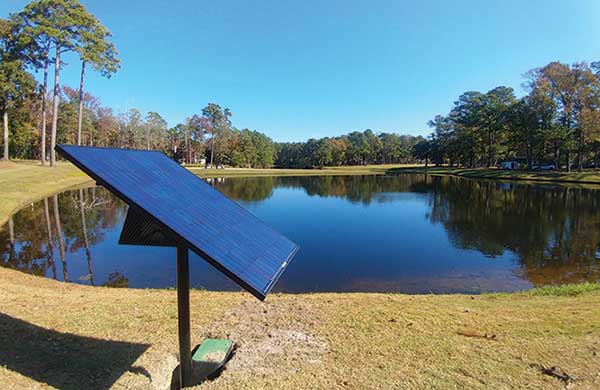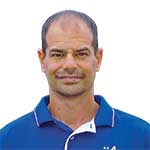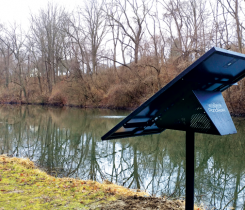Experts’ Insights: Water feature woes

Ponds and other water features often develop algae, which can be cut down by aeration, chemical treatments and adding carp into the pond. (Photo courtesy of Sandra Burton)
Zach Ferone, second assistant at Sycamore Creek CC in Springboro, Ohio, has worked with his fair share of ponds and water features.
With those water features come the costs and labor associated with maintaining them.
“We usually see algae develop when it gets super hot, in those late stagnant dog days of summer going into early fall, especially if we haven’t had any rain,” he says. “During those drought times, we’ll start to see it really pop up.”
His course, Sycamore CC, includes three main water features: a 9-acre reservoir that the course uses for its pump station, a small natural pond and a man-made pond.
In addition to physically removing debris from the water features, golf courses can use various forms of aeration and chemical applications to keep algae in check. However, Sycamore CC is thinking about taking it a step further.
“The man-made feature is the one we have issues with in terms of algae,” he says. “We try to use a fountain to get some aeration through there, and we’ve had the idea of putting grass carp in, which is something I’ve used in the past at other golf course with tremendous success.”
Ferone says the ponds he’s worked with could be stocked with carp once every two years for about $300 each time.
“If you don’t have anything that will eat the algae, phytoplankton keep recycling themselves and keep coming back,” he says. “If you take the time to stock it properly with other wildlife, that’ll help maintain the pond, and it’ll cut down on your man-hours and your costs.”

Headshot: Roy Watkins
Air-O-Lator Corp.
Roy Watkins
President
Aeration is the lifeline to a pond. Without aeration, oxygen levels will drop to levels that will not sustain an aerobic balance of the ecosystem, resulting in organic sludge buildup, high concentrations of nitrates, odors, murky water, algae growth and fish kills. Without proper mixing, dispersion of oxygen throughout the body of water will be insufficient. Water stagnation results in algae, odor and increased mosquito breeding areas. Adding native plants, vegetation and grass to the banks will prevent erosion damage to the shoreline and provide a natural filtration system to runoff entering the pond. As with turf management, some chemical or biological treatment is required to eliminate unwanted weeds and grasses. Don’t forget to dredge the pond as over time, even with good management practices, ponds will accumulate a buildup of sludge.

Headshot: Brian Pirl
U.S. Aqua Vac
Brian Pirl
Vice president of operations
Make sure you watch for sediment levels. Once the mucky sediment starts to expose itself at the surface, it will harden, and it can become a lot more expensive to remove. Make sure you pick up the leaves in the fall. So many times, we see course personnel blow leaves into the pond. In the long run, it costs the course money as it becomes mucky sediment and clogs up their irrigation intake. The sad thing is most of the time, superintendents don’t even know that some of their guys are doing it.

Headshot: Sandra Burton
PondHawk by Linne Industries
Sandra Burton
President and CEO
Using the “treatment train” approach is an easy, effective way for superintendents to employ best management practices (BMPs) in golf course ponds. The treatment train is actually a series of BMPs that work together to slow down and reduce the water and nutrients that enter the pond. The first step is to install swales, berms and riparian buffers to capture pollutants, nutrients and sediments from the runoff before it enters the pond. The next step is to install subsurface diffused aeration to maintain dissolved oxygen and eliminate temperature stratification for the water already in the pond. Dissolved oxygen binds nutrients in the sediment and prevents the reintroduction of nutrients already in the sediment. Maintaining dissolved oxygen and temperature equilibrium also prevents fish kills. Superintendents who get on board with the treatment train will benefit from healthy, clean, pleasant-smelling ponds that golfers will appreciate.

Headshot: Shaun Donahue
Tidewater GC & Plantation, North Myrtle Beach, S.C.
Shaun Donahue
Superintendent
After my first season using solar pond aeration, I realized really quickly that the technology coupled with the ease of use from that system was going to be very successful at our club. We maintain buffers around our ponds with regard to fertilizer and chemical applications to minimize runoff and leaching into the pond system. We also try very hard to manage the waterfowl that utilize the ponds on the property and improve the pond environment for aquatic life. The biggest challenge associated with pond maintenance, for us, is strictly visual. We have shallow ponds, which increase algae instances, so our management practices revolve around keeping the algae to a minimum. Removing unwanted vegetation by hand and clearing out downed trees and limbs requires an increase in labor, especially during hurricane season. The amount of organic trash, like pine straw, leaves and pinecones, that makes its way into the ponds after a storm can be quite significant.











